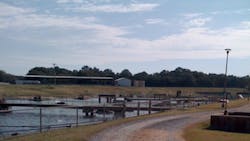Electrical-grid powered aeration in reactor basins at activated-sludge wastewater treatment plants (WWTPs) enables digestion by mixing and oxygenating the wastewater. The purchase of electricity to operate the aerators is a major part of operational expense. The use of electrical-grid power also increases the carbon footprint of WWTPs due to the associated greenhouse gas emissions, thereby contributing to global climate change.
Problems
The City of Eden, N.C., Mebane Bridge Wastewater Treatment Plant, investigated the ability of solar-powered circulation (SPC) technology to provide some of the mixing and oxygenation previously supplied solely by grid-powered aerators. The goal of the initial study was to meet National Pollution Discharge Elimination System (NPDES) standards while reducing grid-powered aeration and operating a single SPC unit in one basin. Study objectives were to compare effluent water quality parameters and grid power usage and cost during one year of SPC treatment with comparable data from the immediately preceding year when only aeration was used.
Methods
The investigation was conducted in the Mebane Bridge WWTP’s south basin, an earthen impoundment 486 ft long (with 2:1 sloping sides), 162 ft wide (with vertical sides) and 13.5 ft deep. Its surface area was 1.74 acres, and its operating volume was 7.0 million gal. The 12 20-hp aerators operated continuously during the pre-SPC treatment period—June 2008 through May 2009. The three aerators closest to the SPC unit remained inactive during daylight hours throughout the SPC treatment period—June 2009 through May 2010. Plant personnel deactivated up to six aerators during the SPC treatment period to assess the limits of the SPC unit to supply mixing and oxygenation. Although the SPC unit operated continuously, personnel activated all aerators during darkness as a precaution.
The parameters measured during both study periods using standard methods were wastewater influent (IN) quantity, effluent (EF), total suspended solids (TSS), biochemical oxygen demand (BOD), acidity or alkalinity (pH), dissolved oxygen (DO), ammonia nitrogen (AN), total nitrogen (TN), total phosphorus (TP) and fecal coliform (FC). Electrical-grid power usage and cost were monitored throughout the study.
Results
No NPDES water quality violations occurred during either study period. Water quality parameters were generally unchanged or improved during the SPC treatment period. The closing of a Hanes textile mill in February 2008 of the pre-SPC study period was associated with an influent decrease of approximately 32%, improvement in several water quality parameters and an increase in TN. An apparently independent decrease in TP was observed during the SPC period.
Both mean monthly electrical-grid power use and cost decreased significantly during SPC. Annual electricity usage declined by 1,692,000 kWh, or 42%, whereas annual expenditure decreased by $61,101, or 31%. The cost savings on electricity resulted in a 10.7-month payback period.
Conclusion
These results obtained at an activated sludge WWTP supported the conclusion reached by the U.S. Environmental Protection Agency in an evaluation of SPC use at four WWTPs. The EPA concluded that SPC reduced grid-powered aeration usage, electricity consumption and operational costs, as well as odor events, sludge buildup and greenhouse gas emissions. Similar results were obtained in a study of SPC use at three pond-based WWTPs conducted by the New Hampshire Department of Environmental Services.



